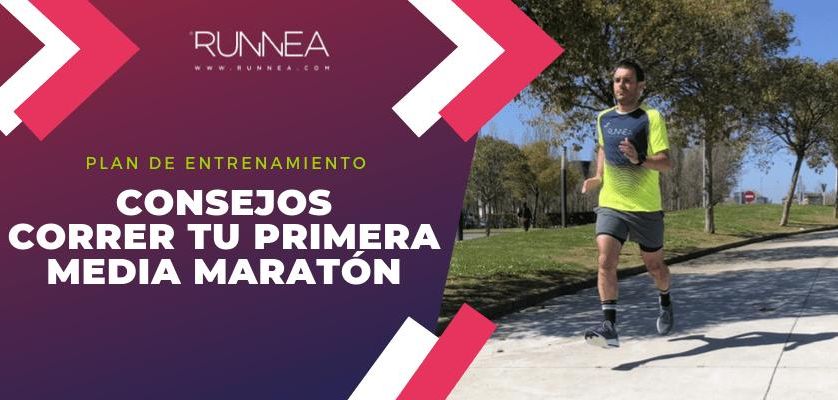You've arrived, congratulations! You've already reached your goal: to run your first half marathon! And we know that it has not been easy, because taking the leap to the long distance involves being well prepared both physically and mentally. And can you really answer yes to this question?
At Runnea we want to become one of your best allies, and we offer you 7 tips to make your debut in a half marathon with guarantees, and above all to reach the date of your great challenge in the best possible shape Take note, put on your Running shoes and train!

7 tips for running your first half marathon
As the challenge of running, for the first time, a half marathon is no small undertaking. The best we can do is to seek qualified advice, and put ourselves in the hands of professionals. So with that clear objective, and with the idea of carrying the most appropriate preparation as possible, we have turned to our head coach Runnea Academy, Iker Muñoz, as well as our nutritionist, Sandra Gervilla. Thus, we have the necessary guidelines both in terms of preparation and physical conditioning, as well as in the nutritional aspect, which is also important and should not be neglected.
Having a base of preparation and progression
It is obvious that to prepare for a half marathon, especially for runners who are new to the 21k distance, it is necessary to have a base of preparation, and that this is also based on an effective method of progression. That is, running a 5k and/or 10k race before taking the leap to tackle this long-distance event.
"The main factor is that we have to be aware that we need time to prepare for this new distance. A half marathon will require longer runs, and therefore more impacts on our legs, so we will have to adapt and allow time to recover," says Iker Muñoz, PhD in Physical Activity and Sport Sciences.
Therefore, the so-called training demands are fundamental to adapt your training plan to your needs, and mainly to adapt it to your current physical condition. It is important to understand that training plans not only vary in duration, but also in content, and that you will have to adapt them to your working day, as well as to your family and social life.

Quality versus quantity of kilometers
As we have already mentioned, when preparing for your first half marathon, there are no secrets or miracle formulas. You have to add kilometers to your legs, but it is also about running more efficiently, and not like a headless chicken. This is where quality over quantity comes into play.
"If we are looking to improve our performance the days of series or intervals will be necessary. There is no one method that is superior to another, what will be necessary is to schedule when and what type of work we are going to do. For example, we can start introducing intensity days in the form of interval training to later perform series work", emphasizes our Runnea Academy coach.
This specific series work, or also known as fartlek, has its medical reason, and is that it allows you to increase your VO2Max -the ability to use oxygen to produce energy in the body-, while you also get rid of that strange feeling that your legs burn, to expel lactate.
On the other hand, these progressive runs can also help us to make our training sessions more bearable, fun and enjoyable, and thus break the monotony of long-distance runs. Although the nuance to add is that as long-distance runners we should be able to "work on the same objective in different ways to break the monotony of long-distance training," Muñoz points out.
Don't get obsessed with the idea that long runs, and in a single training session, should cover the distance of the half marathon in order to compete with maximum guarantees, because it's not necessary, as long as we arrive with our homework well done.
Include strength exercises in your training plan.
Not only to condition your body to the physical demands of running a half marathon, but also as a method of injury prevention, but strength exercises have to be included in your training plan.
"If you dedicate two days a week, in 30-minute sessions, to strength work, your legs will thank you for it. Although, like everything else, it will be limited by the time available," says Iker Muñoz.
In this sense, strength work doesn't have to be associated with going to the gym, and you also have the opportunity to resort to cross training and light resistance training, which doesn't involve having to go running. You will optimize your fitness and also become more resistant to fatigue.
Rest, and avoid overtraining.
At Runnea we have already stressed it to you on more than one occasion, but it is as important to rest as it is to train. Even if you feel good, strong and eager to continue, you can't skip rest days. These must also be scheduled in your training plan, and you must adhere to them to the letter.
Your body is wise, and you should listen to it, because skipping those rest days significantly limits the body's ability to recover; and you also increase, exponentially, the risk of suffering a possible injury that leaves you in the dry dock. So it is better to be safe than sorry.
With all this in mind, and barring illness, controlling your resting heart rate will help you keep the dreaded overtraining at bay, because if your heartbeat is higher than normal, that's a clue that your body needs to stop and rest.

Staying motivated in every workout
In all this process of preparing for a half marathon, you will have doubts. It's logical, and normal. On more than one occasion you will be assailed by the questions of: "Who told me to go to all this trouble? Immediate call for motivation.
"At that moment it is necessary to think about our goal and the effort we have made and how good we feel after having done that hard training, in addition to observing how we are progressing. In other words, we need to set ourselves achievable and short, medium and long-term goals. If after the first training session of our life we think about the half marathon we have to do in five months, I'm afraid that we will probably not finish the second week of training", makes clear this teacher-researcher at the European University of the Atlantic (Santander), and passionate about popular races on asphalt and trail.
Nutrition, a section that should not be put on the back burner
It is also evident that, in addition to training and resting, it is also vital to pay attention to our nutrition, because what we call invisible training is a fundamental part of our preparation to arrive in optimal conditions the day we start the half marathon.
Therefore, as Sandra Gervilla, a graduate in Human Nutrition and Dietetics from the University of Lleida, points out: "At the end of each training session it is important to stress the need to replenish water and carbohydrate needs". And his quickest and most effective proposal to replenish these post-race and/or post-workout food demands is to resort to"a mixed carbohydrate and, to a lesser extent, protein shake, with the idea of replenishing glycogen reserves".
With everything we have pointed out in this post, you have part of the theory to apply with these tips, and get going to achieve that goal of running your first half marathon, but always go to practice with common sense, and listening to your body, at all times It is also important to enjoy the road, sometimes even fills more than overcoming the finish line!
Read more news about: Running Training





























